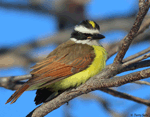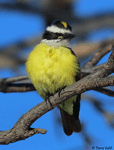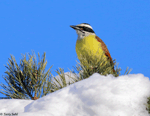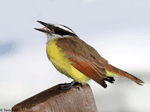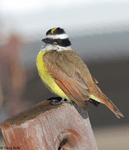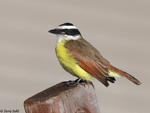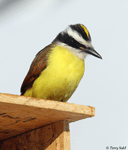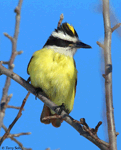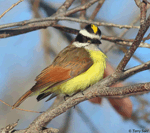| Length: 9.5 inches | Wingspan: 15 inches | Seasonality: Extremely rare visitor |
| ID Keys: Distinctive, with black and white striped head, yellow belly, white throat, and rufous-colored uppperside | ||
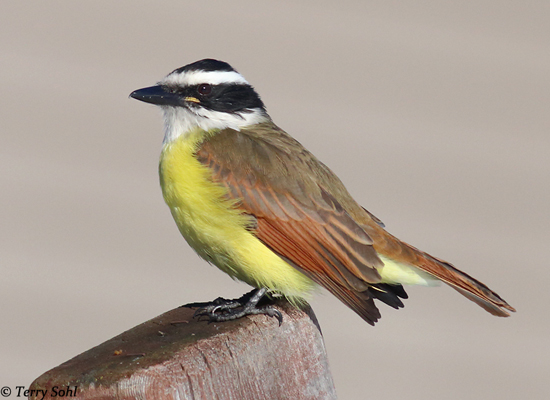 The
Great Kiskadee is a tropical flycatcher, quite dissimilar in appearance to other
flycatchers typically found in the United States. It differs not only in
looks, but also in behavior. In addition to flying out from a perch to
grab insects (ala most flycatchers), the Great Kiskadee also acts like a shrike
at times, pouncing on lizards or other small vertebrates, and will even fish
like a kingfisher. This adaptable and opportunistic bird is a common sight
throughout Latin America. The species is named after it's loud calls.
In South Dakota, they were an unknown species until 2015, listed as
"hypothetical" based on an unconfirmed sighting of one in the state. Given that
no surrounding states had any sightings of the bird, further sightings of the
bird were clearly not expected. However, in the fall of 2015, at least one
and possibly up to three different Great Kiskadees were found at a farmstead
near Volga, South Dakota. At least one bird survived into December.
The
Great Kiskadee is a tropical flycatcher, quite dissimilar in appearance to other
flycatchers typically found in the United States. It differs not only in
looks, but also in behavior. In addition to flying out from a perch to
grab insects (ala most flycatchers), the Great Kiskadee also acts like a shrike
at times, pouncing on lizards or other small vertebrates, and will even fish
like a kingfisher. This adaptable and opportunistic bird is a common sight
throughout Latin America. The species is named after it's loud calls.
In South Dakota, they were an unknown species until 2015, listed as
"hypothetical" based on an unconfirmed sighting of one in the state. Given that
no surrounding states had any sightings of the bird, further sightings of the
bird were clearly not expected. However, in the fall of 2015, at least one
and possibly up to three different Great Kiskadees were found at a farmstead
near Volga, South Dakota. At least one bird survived into December.
Habitat: Can occur in most habitats with trees, but is often found in woodlands or other trees near streams and poinds. They typically need both trees and open lands, and avoid dense forest.
Diet: Will feed on a wide variety of items, both vegetable and animal matter. Often feeds on large insects, but will also take fish, lizards, tadpoles, small mice, baby birds, and eggs. Also feeds on fruits and berries.
Behavior: Very adaptable, using a wide variety of hunting methods (as mentioned in the introduction).
Nesting: Builds nests in thick foliage of a large shrub or tree, typically from 10 to 30 feet up.
Breeding Map: Non-breeder in South Dakota
Song: Species is named after it's loud and conspicuous call, which is often repeated in concert with several other adjacent birds.
Migration: Typically a permanent resident throughout its range. Not known to wander widely.
Interactive eBird Map: Click here to access an interactive eBird map of Great Kiskadee sightings
Similar Species: Distinctive in the United States, but several other tropical flycatchers are similar in appearance.
Conservation Status: Very common, adaptable, and increasing in number and possibly in range.
Further Information: 1) Patuxent Bird Identification InfoCenter: Great Kiskadee
2) Whatbird.com: Great Kiskadee
3) Audubon Guide - Great Kiskadee
Photo Information: December 2nd, 2015 - Near Volga in South Dakota - Terry Sohl
| Click on the map below for a higher-resolution view |
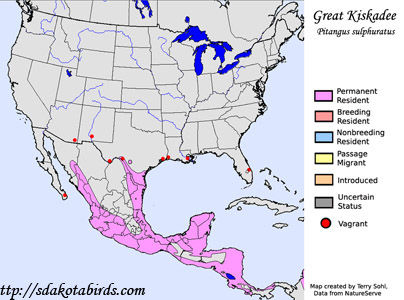 |
| South Dakota Status: Unknown in South Dakota until the fall of 2015, when at least two individuals were found near a farmstead south of Volga. The land owners first noticed the birds in August, and in early December of 2015, at least one bird was still surviving, living on suet and mealworms put out for it by the land owner. |
Additional Great Kiskadee Photos
